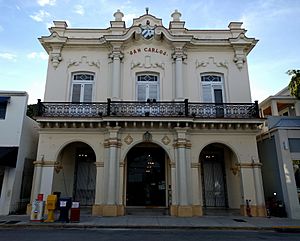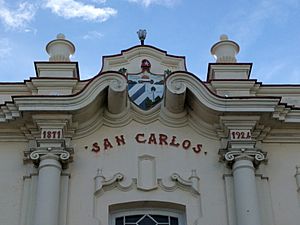San Carlos Institute facts for kids
The San Carlos Institute, often called the San Carlos, is a special place in Key West, Florida. It's a Cuban heritage center and museum. It helps keep Cuban language, culture, and history alive.
This institute was started in 1871 by Cubans who had moved to Key West. They wanted a place to share their traditions. Today, the San Carlos is many things in one! It's a museum, a library, a school, and even a theater. It also hosts many fun cultural events and art shows.
Contents
History of the San Carlos Institute
The San Carlos Institute began in 1871. It was founded by Cubans who came to Key West during the Ten Years' War (1868-1878). This war was a fight for Cuba's freedom from Spain. Leaders like Juan María Reyes and José Dolores Poyo helped start it. They wanted a place for Cuban culture, meetings, and learning.
The institute first opened on Anne Street in November 1871. It grew quickly and moved to a bigger building in 1884. But in 1886, a big fire damaged much of Key West, including the San Carlos. With help from Martín Herrera, the community rebuilt the institute. It opened at its current spot on Duval Street in 1890.
A Key Place for Cuban Freedom
The San Carlos Institute was very important for Cuba's fight for independence. It was a meeting spot for leaders and the Cuban community in Key West. One famous speaker was José Martí, a Cuban revolutionary.
Starting in January 1892, Martí visited Key West many times. He wanted to get support and money for the independence movement. He also worked to unite the Cuban community. After many talks, Martí held a big meeting at the San Carlos. There, he announced that the community was united to fight for Cuba's freedom.
Martí's hard work in Key West and other places helped create the Cuban Revolutionary Party. This was a big step towards Cuba winning its independence.
Saving a Historic Building
For over 100 years, the San Carlos Institute had a special school. It was one of the first schools in the United States to teach in two languages (Spanish and English). It also welcomed children of all races.
However, in 1973, the San Carlos had to close. It ran out of money, and the building was falling apart. It stayed closed and damaged for almost 20 years.
In 1981, part of the building's front fell off, hurting a tourist. People worried the historic San Carlos would be torn down. The local Cuban community worked hard to save it. The State of Florida helped by giving $2.8 million for repairs. A lawyer named Rafael A. Peñalver Jr. was also very important in raising money and leading the restoration.
The San Carlos Institute reopened in January 1992 with a big celebration. Later, it was named a Florida Literary Landmark. A special plaque was placed there to honor José Martí's writings and his fight for Cuban independence.
What You Can See and Do
The San Carlos Institute has many interesting exhibits about Cuban history and the Cuban-American community in Florida:
- The Life and Works of José Martí: 1853 - 1895. This exhibit shows photos and documents about José Martí's life. It highlights his contributions to Cuba's freedom.
- The Pichs Collection: Exploring Cuba's History through its Postal Stamps. This is an online exhibit with the Smithsonian Institution's National Postal Museum. It shows Cuba's postal history from 1830 to 1939. There's also a virtual exhibit about Cuba's commercial aviation history.
- Portraits of Cuba's Presidents. This exhibit features pictures of Cuba's presidents from 1902 to 1952.
- History of the San Carlos Institute. This exhibit tells the story of the San Carlos Institute from its opening in 1871 up to 2008.
The San Carlos also hosts many cultural, historical, and artistic events throughout the year:
- Key West Literary Seminar. Held every January, this event brings famous writers from around the world. They give readings, lead workshops, and have discussions. Many main events happen in the San Carlos Institute's theater.
- Key West Film Festival. The San Carlos helps sponsor this festival. It's one of the places where film screenings and parties happen.
- Key West Songwriter's Festival. The San Carlos also sponsors this music festival. It's one of the places where musicians perform their songs.



